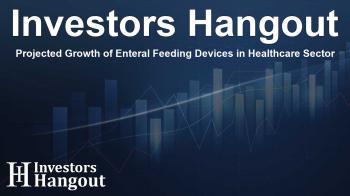Projected Growth of Enteral Feeding Devices in Healthcare Sector

Overview of the Enteral Feeding Devices Market
The global enteral feeding devices market is anticipated to reach a remarkable value of US$3,994.2 million by 2030, expanding at a compound annual growth rate (CAGR) of 6.0% from 2025. This growth can be attributed to a multitude of factors such as advances in technology, a growing geriatric population, enhanced awareness of nutritional requirements, and increased support from regulations. Enteral feeding devices are essential for providing nutritional support to individuals who cannot consume food through traditional means, especially patients in critical conditions.
Growth Drivers of the Market
A significant driver for the growth of the enteral feeding devices market is the aging population, which tends to have more health issues requiring nutritional support. Furthermore, technological innovations in enteral feeding systems, including improved materials, designs, and functionalities, are enhancing patient care. The integration of digital technologies into these devices is leading to enhanced patient monitoring and care efficiency.
Technological Innovations
Developments in enteral feeding systems, such as advanced pump technologies, anti-clogging mechanisms, and real-time monitoring features, are fundamentally transforming patient care. These innovations not only simplify the delivery of nutrition but also ensure that patients receive their nutritional needs effectively and safely. The ongoing research in this field aims at refining these devices further to enhance their performance and reliability.
Market Segmentation
The enteral feeding devices market is categorized based on various parameters, including product type, application area, and end-user demographics. Product segments include enteral feeding tubes, enteral feeding pumps, and a range of accessories essential for nutritional delivery. Each segment contributes distinctly to the overall market growth.
Product Types and Their Significance
Within the product categories, enteral feeding tubes are significant, including nasogastric tubes, gastrostomy tubes, and jejunostomy tubes among others. These tubes serve essential roles in delivering nutrients directly into the stomach or small intestine, which is vital for patients who are unable to eat by mouth. The demand for these tubes is growing not only due to their life-saving potential but also because of advancements like easier insertion and safer materials.
Applications of Enteral Feeding Devices
The applications of enteral feeding devices extend across oncology, neurological disorders, and metabolic conditions. Oncology is projected to remain the leading application area, driven by the rising prevalence of malnutrition in cancer patients. Supportive care during cancer treatments has increased the necessity for enteral feeding devices, which enable better management of nutritional intake.
Rising Incidence of Malnutrition
Malnutrition is a serious condition that affects many cancer patients, making enteral feeding devices vital tools in modern oncology healthcare. The increasing awareness regarding nutritional management and the need for tailored nutritional support signifies the essentiality of these devices in clinical settings.
End-User Distribution
In terms of end-users, hospitals and surgical centers dominate the enteral feeding devices market. Factors like patient safety, regulatory compliance, and increased patient outcomes are propelling the growth of enteral feeding device usage in these facilities. The integration of newer technologies into hospital management is also a critical factor, enhancing the efficacy of nutritional support systems.
Geographical Insights
The geographical segmentation indicates that North America exhibits a significant share of the market, impacted by increased investment in healthcare infrastructure and a proactive approach toward adopting innovative technology for patient care. Growing public awareness surrounding nutrition is also contributing to the rise in demand for enteral feeding devices.
Future Outlook and Innovations
Looking forward, companies are expected to innovate continuously to meet the consumer and healthcare needs posed by wide-ranging medical conditions. New products with enhanced features are in the pipeline, encouraging healthcare systems to adopt them seamlessly. As this market evolves, there will be a strong focus on improving design complexity and establishing supportive networks for caregivers.
Frequently Asked Questions
What is the projected value of the enteral feeding devices market by 2030?
The market is expected to be valued at US$3,994.2 million by 2030.
What factors are driving the growth of this market?
Key drivers include technological advancements, demographic shifts, and increasing awareness of nutritional needs.
Which application area dominates the enteral feeding devices market?
Oncology is the leading application area due to high malnutrition rates in cancer patients.
What types of products are included in the enteral feeding devices market?
Product types include enteral feeding tubes, pumps, and various accessories.
What is the significance of technological innovation in this field?
Technological innovation enhances patient care, safety, and device efficiency in nutritional delivery.
About The Author
Contact Owen Jenkins privately here. Or send an email with ATTN: Owen Jenkins as the subject to contact@investorshangout.com.
About Investors Hangout
Investors Hangout is a leading online stock forum for financial discussion and learning, offering a wide range of free tools and resources. It draws in traders of all levels, who exchange market knowledge, investigate trading tactics, and keep an eye on industry developments in real time. Featuring financial articles, stock message boards, quotes, charts, company profiles, and live news updates. Through cooperative learning and a wealth of informational resources, it helps users from novices creating their first portfolios to experts honing their techniques. Join Investors Hangout today: https://investorshangout.com/
The content of this article is based on factual, publicly available information and does not represent legal, financial, or investment advice. Investors Hangout does not offer financial advice, and the author is not a licensed financial advisor. Consult a qualified advisor before making any financial or investment decisions based on this article. This article should not be considered advice to purchase, sell, or hold any securities or other investments. If any of the material provided here is inaccurate, please contact us for corrections.

